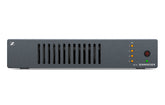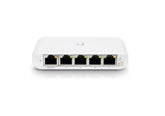How to Build a Scalable and Secure Business Network
Introduction: Why Network Design Is Business-Critical in 2025
Did you know that 60% of small businesses fail within six months of a major cyberattack? In an age where nearly every device, transaction, and communication depends on digital connectivity, your business network isn’t just IT infrastructure—it’s the backbone of your success.
Whether you're running a retail operation, warehouse, remote team, or AV installation, building a scalable and secure business network ensures you can grow, adapt, and defend against modern threats. But balancing speed, flexibility, and security is no small feat.
In this guide, we’ll walk you through how to create a business network that meets today’s performance standards while preparing for tomorrow’s challenges. From infrastructure and hardware to segmentation and cybersecurity protocols, you'll gain actionable strategies to future-proof your connectivity and protect what matters most.
What Is a Scalable and Secure Business Network?
A scalable and secure business network is an infrastructure designed to grow alongside your organization while protecting data, users, and devices from internal and external threats. It enables reliable communication, seamless access to applications, and remote collaboration—without compromising on safety or performance.
Scalability means your network can handle:
-
More users and devices
-
New locations or departments
-
Higher traffic and bandwidth demands
-
New technologies like cloud apps, IoT devices, or video streaming
Security means:
-
Threat detection and prevention
-
Data encryption and access control
-
Network segmentation to isolate risk
-
Compliance with industry standards like PCI-DSS or HIPAA
A well-designed business network should be:
-
Fast: Minimal latency and downtime
-
Flexible: Easy to upgrade and reconfigure
-
Secure: Resistant to breaches, malware, and unauthorized access
-
Centralized: Managed with cloud tools and automation
Benefits and Use Cases for Scalable and Secure Networks
1. Seamless Growth and Expansion
As your company adds employees, locations, or digital tools, your network must scale to meet those needs without starting from scratch.
Use Case: A regional retailer adds three new stores and integrates each with the main data center, maintaining consistent POS systems and cloud access across the board.
2. Support for Modern Workflows
With the rise of hybrid work, smart devices, and real-time collaboration tools, businesses need networks that can support high traffic, cloud apps, and video conferencing without lag.
Use Case: A remote marketing team uses cloud-based editing tools, VoIP calls, and live webinars—all supported by a bandwidth-optimized, QoS-enabled network.
3. Enhanced Cybersecurity
Modern cyber threats are increasingly automated and AI-driven. A secure network includes firewalls, intrusion detection, access management, and patching systems that evolve with the threat landscape.
Use Case: A medical practice uses VLAN segmentation to isolate patient records from public Wi-Fi and implements two-factor authentication across all endpoints.
4. Reduced Downtime and IT Costs
Smart, centralized management allows IT teams to proactively monitor, troubleshoot, and update networks across multiple sites without costly onsite visits.
Use Case: A warehouse runs 24/7 operations supported by a mesh network with self-healing capabilities, reducing downtime caused by single-point failures.
Browse high-performance networking hardware designed to power secure, scalable networks.
Challenges and Considerations
Legacy Infrastructure
Many businesses operate on outdated switches, routers, or cabling that can’t support modern speeds or device loads.
Solution: Upgrade to Gigabit or 10-Gigabit Ethernet, PoE switches, and Wi-Fi 6 access points to eliminate bottlenecks.
Inadequate Network Segmentation
Lumping all users and devices into a single flat network creates security risks and performance issues.
Solution: Use VLANs to segment traffic based on user roles, device types, or departments.
Lack of Centralized Management
Without unified tools, IT teams struggle to maintain visibility, enforce policies, or push updates across systems.
Solution: Implement cloud-managed networking platforms like Cisco Meraki or Ubiquiti UniFi to enable centralized monitoring and remote troubleshooting.
Security Blind Spots
From unsecured endpoints to unencrypted traffic, poor security hygiene can lead to devastating breaches.
Solution: Enforce end-to-end encryption, use strong authentication protocols, and regularly update firmware and passwords.
Scalability Planning Gaps
Failing to plan for future growth can result in expensive overhauls down the line.
Solution: Design your network with modular components, scalable bandwidth, and flexible routing infrastructure that can adapt as you expand.
How to Build a Scalable and Secure Business Network
Step 1: Map Out Your Current and Future Network Needs
-
How many users and devices will your network support?
-
What are your mission-critical applications?
-
Will you be adding offices, retail locations, or warehouse facilities?
-
Do you need wireless-only, wired-only, or a hybrid environment?
Create a network topology diagram outlining switches, routers, APs, and firewalls—and account for future expansion zones.
Step 2: Choose the Right Networking Equipment
Essential Components:
-
Business-grade routers and firewalls with built-in threat detection
-
Managed switches with VLAN support
-
Wi-Fi 6 access points for dense environments
-
PoE switches for cameras, VoIP phones, and APs
-
UPS battery backups to prevent data loss during outages
Avoid residential-grade equipment. It lacks the performance, security, and reliability needed for business environments.
Step 3: Implement Network Segmentation
Divide your network into logical groups:
-
Admin
-
Guest
-
IoT Devices
-
Surveillance Systems
-
Point-of-Sale Systems
Benefits:
-
Limits the spread of malware
-
Improves performance through traffic prioritization
-
Helps meet regulatory requirements
Step 4: Secure Every Layer of the Network
-
Use WPA3 encryption for Wi-Fi
-
Enforce multi-factor authentication (MFA) on critical systems
-
Deploy intrusion prevention systems (IPS) and antivirus
-
Enable automatic firmware updates on routers, switches, and APs
-
Create strong password policies and rotate credentials regularly
Consider using a zero trust network architecture (ZTNA) for high-security environments.
Step 5: Centralize Management and Monitoring
Adopt cloud-based network management for:
-
Real-time traffic monitoring
-
Automated device provisioning
-
Remote troubleshooting
-
Bandwidth usage alerts
-
Security event logging
Popular Tools:
-
Cisco Meraki
-
Aruba Central
-
UniFi Controller
-
NetCloud by Cradlepoint
Step 6: Optimize for Performance
Use QoS (Quality of Service) to prioritize mission-critical traffic (VoIP, POS, video calls). Analyze traffic logs to spot bottlenecks or devices hogging bandwidth.
Tips:
-
Allocate bandwidth to departments based on function
-
Set usage policies for guest Wi-Fi
-
Monitor latency and packet loss in high-priority apps
FAQs
How many devices can a business-grade network handle?
That depends on the equipment. A typical SMB network with enterprise-grade switches and routers can support hundreds of devices when properly segmented and optimized.
What’s the difference between managed and unmanaged switches?
Managed switches allow VLAN creation, traffic control, and remote configuration. Unmanaged switches are plug-and-play but lack advanced features—best for small offices or temporary setups.
Do I need a firewall if I already have antivirus?
Yes. Firewalls protect your network perimeter, while antivirus protects individual endpoints. Both are essential parts of a layered security approach.
Conclusion: Build Smart Now, Scale Confidently Later
In today’s fast-paced digital world, a strong network isn’t just about fast Wi-Fi—it’s about building a system that adapts to growth, supports productivity, and defends against evolving cyber threats.
A scalable and secure business network ensures:
-
Faster operations
-
Safer data handling
-
Improved customer experiences
-
Lower IT costs over time
By investing in the right infrastructure, planning for scalability, and prioritizing security, your business can stay connected, competitive, and resilient in any market.
Need the right tools to start building?
Explore our curated collection of business networking gear, AV systems, and surveillance technology at SportsGeekUSA today.











